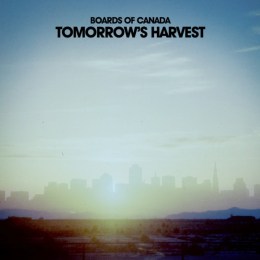
![]()
This post is in partnership with Consequence of Sound, an online music publication devoted to the ever growing and always thriving worldwide music scene.
Musically, Sandison and Eoin don’t stray too far from their own beaten path. The seraphic ambiance of 1998′s Music Has the Right to Children, which has seen been split into the dark (2002′s Geogaddi) and the light (2005′s The Campfire Headphase), reemerges weathered and with a newfound sense of purpose. The two ignore the clock on Harvest, allowing the presence to linger and take seconds (sometime minutes) to stir, floating about in a reflective state as if there’s no time. Granted, it’s only an hour in length, but the 17 tracks collectively can feel as long and testing as a second viewing of Koyaanisqatsi, namely because the bigger pieces are strung together by erratic vignettes, conceptual devices used in something as recent as M83′s Hurry Up, We’re Dreaming to pretty much every major film score of the last 50 years. “Telepath” tosses signals over empty terrain, as a fractured computer clenches on to life (think of HAL 9000, only voiced by John Hurt on Vicodin); “Transmisiones Ferox” stutters through a droning crackle that deafens with its alarming beat; “Uritual” stuns with flighty treble and teardrop tracings; and “Sundown” soothes with synths borrowed from The X-Files composer Mark Snow. The reason any parallels to science-fiction can be made is because of these patchy bridges.
That’s not to say the album’s main events don’t evolve its concept, either. Earlier track “Reach for the Dead” is a compression of futility and mechanized chaos, no different than Brad Fiedel’s iconic Terminator scores. It’s a vintage industrial ballad that widens the frame on the post-apocalyptic world created by Sandison and Eoin. The way the silicone percussion evaporates at the end even makes it feel like the opening credits, a pastiche that resurfaces on closing tracks “Come to Dust” and ”Semena Mertvykh.” There’s a sense that whatever action is taking place throughout Harvest finishes before the former’s end, leaving the latter as this ominous underbelly. To put into perspective, and to continue the filmic parallel, “Come to Dust” bleeds into the credits, while “Semena Mertvykh” presses on towards the very, very end, playing to an empty theater, or those still around to find out about filming locations, soundtrack choices, and whether or not animals were harmed in the film. The album’s final 25 seconds of white noise only speaks volumes about the cinematic concept.
And what works about said concept is that, much like all of Boards of Canada’s material, it’s subjective to the listener. Sandison and Eoin have crafted an emotionally-stirring, calculated epic of ambient electronica, but what you see and experience is really out of their hands. They’re aware of that, too, as Sandison suggested: ”It’s better if listeners find the narrative themselves, in the titles and the sounds.” So, whether you’re dreaming up another Snake Plissken adventure amidst the helicopters of “White Cyclosa,” dancing tribally to the post-modern percussion of “Palace Posy,” gazing towards the vacant skies of “Cold Earth,” salvaging through garbage heaps on “Jacquard Causeway,” or finding sanity in madness on “Nothing is Real,” you’re going somewhere and it’s likely that somewhere is within arm’s reach of their somewhere.
Mystery factors into much of Tomorrow’s Harvest. From the obscure viral marketing that led up to its release — the Record Store Day exclusives, barcodes, late night commercials, isolated listening party in the desert, that projection on the building in Tokyo, and the time they dropped sounds at a festival in Detroit — to the puzzling themes that lie within the album’s thick, carbonite walls, Boards of Canada have made fans believers and passersby into fans in the past two months. It’s not like they didn’t know how, either. As Eoin suggested: “It’s in human nature to pursue spiritual or fantastic things, for whatever reason, that’s why we like art and escapism, isn’t it? Humans like to feel there’s a purpose, even if there isn’t one!” Eight years later, the two remain connected to our most intimate sensibilities, and while their latest transmission isn’t the easiest to receive, upon success, it can be the most rewarding piece of science fiction in years.If this is the end of the world, I’m inclined to agree with Michael Stipe.
Essential Tracks: ”Jacquard Causeway,” ”Cold Earth,” “Semena Mertvykh,” and “Sundown”
